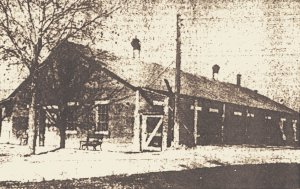|
When the Dallas Park Board assumed responsibility for White Rock Lake in 1929, it also inherited the "Pea Patch," a city prison farm located near the dam, where non-violent offenders worked off their fines at the rate of one dollar per day. (In 1934, this rate was increased to $3 per day.) The term "Pea Patch" was probably derived from the garden where prisoners were put to work growing some of their own food. During the night, they were incarcerated in cells in a brick building. For years, a common phrase heard around Dallas was: "You better not get into trouble, sonny boy, they will send you to the 'pea patch' at White Rock."
During the early years, prisoners built public toilets, a bridge spanning Dixon Branch, and storage sheds made from corrugated iron. After the Park Department was given responsibility for the facility, the long-established practice of using prisoner work crews to pick up trash and cut weeds was continued. Initially, the expense of running the facilty was paid for out of the municipal farm fund but during the 1930 fiscal year, the fund was overdrawn by $4,600. Beginning in 1931, the Park Department received 50 cents per day, per offender, as compensation for taking care of them.
Generally, the prison farm housed from fifteen to thirty-five offenders. Depending upon the number of prisoners, there were one or two men assigned to guard them. A cook was also employed. By the time the farm was closed there were only five prisoners in residence.
For many years this system was viewed as beneficial to all parties involved: A indigent prisoner was able to pay off his fine with work instead of money, the city got cheap labor, the lakeshore was kept clean and tidy, and the jailor had fewer prisoners to guard. After the park became more heavily used, however, there began to be complaints that prisoners were "unsightly," rude, or "unknowledgeable when a visitor asked a question." This led the Park Board to question the suitability of the practice and on January 22, 1935, it came to an end (although there were some instances during the 1940s and 1950s when it was temporarily re-instituted).
According a report in the Daily Dallas Times Herald, the "Pea Patch" was closed "because there [were] so few prisoners...sent there to work out fines that the labor from the prisoners [did not] justify the expense of operatiing the institution." In the same story, the paper noted that if the Texas State legislature ever reduced the $3 a day rate at which prisoners worked off their fines to $1 per day, then the facility might reopen. The paper also remarked that the "passing of the farm will bring tears to the eyes of ex-dope addicts, who were cured of the habit by hard work and proper diet at the institution."
|

The above photograph originally appeared in the Jan. 23, 1935 edition of the Daily Dallas Times Herald.
Sources:
Dallas Morning News, Aug., 1931.
Daily Dallas Times Herald, Jan. 22 & 23, 1935.
Gerald Saxon, ed., Reminiscences: A Glimpse of Old East Dallas (Dallas: Dallas Public Library, 1983), 439.
|
